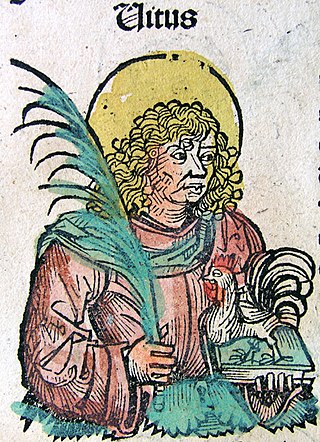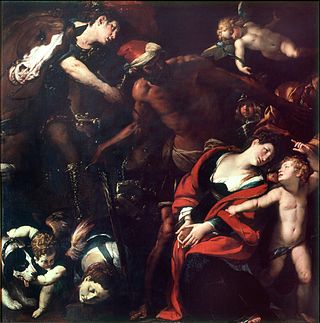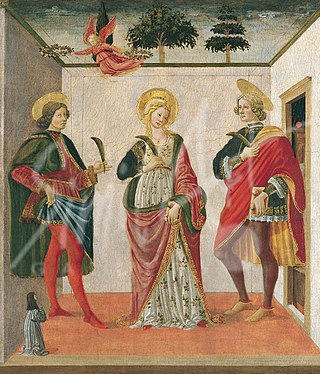
Antipope Felix II, an archdeacon of Rome, was installed as Pope in 355 AD after the Emperor Constantius II banished the reigning Pope, Liberius, for refusing to subscribe to a sentence of condemnation against Saint Athanasius.
Pope Felix I was the bishop of Rome from 5 January 269 to his death on 30 December 274.

Pope Anacletus, also known as Cletus, was the bishop of Rome, following Peter, and Linus. Anacletus served between c. AD 79 and his death, c. AD 92. Cletus was a Roman who, during his tenure as pope, ordained a number of priests and is traditionally credited with setting up about twenty-five parishes in Rome. Although the precise dates of his pontificate are uncertain, he "...died a martyr, perhaps about 91". Cletus is mentioned in the Roman Canon of the mass; his feast day is April 26.

Pope Marcellinus was the bishop of Rome from 30 June 296 to his death in 304. A historical accusation was levelled at him by some sources to the effect that he might have renounced Christianity during Emperor Diocletian's persecution of Christians before repenting afterwards, which would explain why he is omitted from lists of martyrs. The accusation is rejected, among others, by Augustine of Hippo. He is today venerated as a saint in the Catholic Church and in the Serbian Orthodox Church.

Vitus, whose name is sometimes rendered Guy or Guido, was a Christian martyr from Sicily. His surviving hagiography is pure legend. The dates of his actual life are unknown. He has for long been tied to the Sicilian martyrs Modestus and Crescentia but in the earliest sources it is clear that these were originally different traditions that later became combined. The figures of Modestus and Crescentia are probably fictitious.

Saint Valentine was a 3rd-century Roman saint, commemorated in Western Christianity on February 14 and in Eastern Orthodoxy on July 6. From the High Middle Ages, his Saints' Day has been associated with a tradition of courtly love. He is also a patron saint of Terni, epilepsy and beekeepers. Saint Valentine was a clergyman – either a priest or a bishop – in the Roman Empire who ministered to persecuted Christians. He was martyred and his body buried on the Via Flaminia on February 14, which has been observed as the Feast of Saint Valentine since at least the eighth century.

Abdon and Sennen, variously written in early calendars and martyrologies Abdo, Abdus, and Sennes, Sennis, Zennen, are recognized by the Catholic Church and Eastern Orthodox Church as Christian martyrs, with a feast day on 30 July. In some places they have been honoured on 20 March, and the first Sunday of May.
Cyriacus, sometimes Anglicized as Cyriac, according to Christian tradition, is a Christian martyr who was killed in the Diocletianic Persecution. He is one of twenty-seven saints, most of them martyrs, who bear this name, of whom only seven are honoured by a specific mention of their names in the Roman Martyrology.

Gorgonius or Gorgon was a Christian who was martyred in AD 304 alongside Peter Cubicularius and a certain Dorotheus at Nicomedia during the Diocletianic Persecution.

Saints Primus and Felician (Felicianus) (Italian: Primo e Feliciano) were brothers who suffered martyrdom about the year 304 during the Diocletian persecution. The Martyrologium Hieronymianum gives under June 9 the names of Primus and Felician who were buried at the fourteenth milestone of the Via Nomentana (near Nomentum, now Mentana).

Mark and Marcellian are martyrs venerated as saints by the Roman Catholic Church and the Eastern Orthodox Church. Their cult is sometimes associated with that of Saints Tranquillinus, Martia, Nicostratus, Zoe, Castulus, and Tiburtius, though not in the official liturgical books of the Church, which mention only Mark and Marcellianus among the saints for 18 June. Their mention in the General Roman Calendar on that date from before the time of the Tridentine calendar was removed in the 1969 revision, because nothing is known about them except their names, the fact of their martyrdom, and that they were buried on 18 June in the cemetery of Santa Balbina on the Via Ardeatina.

Nereus and Achilleus are two Roman martyr saints. In the present General Roman Calendar, revised in 1969, Nereus and Achilleus (together) are celebrated on 12 May.

Susanna of Rome was a Christian martyr of the Diocletianic Persecution. Her existing hagiography, written between about 450 and 500 AD, is of no historical value and the relations it attributes to Susanna are entirely fictitious. It is probable that a real martyr named Susanna lies behind the literary invention.

Petronilla is an early Christian saint. She is venerated as a virgin by the Catholic Church. She died in Rome at the end of the 1st century, or possibly in the 3rd century.

Rufina and Secunda were Roman virgin-martyrs and Christian saints. Their feast day is celebrated on 10 July.

Saint Hermes, born in Greece, died in Rome as a martyr in 120, is venerated as a saint by the Catholic Church and the Eastern Orthodox Church. His name appears in the Martyrologium Hieronymianum as well as entries in the Depositio Martyrum (354). There was a large basilica over his tomb that was built around 600 by Pope Pelagius I and restored by Pope Adrian I. A catacomb in the Salarian Way bears his name.
Basilides, Cyrinus, Nabor and Nazarius are saints of the Catholic Church, mentioned in the Martyrology of Bede and earlier editions of the Roman Martyrology for 12 June as four Roman martyrs who suffered death under Diocletian.
Marcellus and Apuleius were third- or fourth-century martyrs who were inserted in the General Roman Calendar in the 13th century. They were recognized as saints by the Catholic Church, with 7 October as their feast day. Apuleius is considered purely legendary, and is no longer recognized.

Agapitus is venerated as a martyr saint, who died on August 18, perhaps in 274, a date that the latest editions of the Roman Martyrology say is uncertain.

Saints Tiburtius, Valerian, and Maximus are three Christian martyrs who were buried on 14 April of some unspecified year in the Catacombs of Praetextatus on the Via Appia near Rome.
















